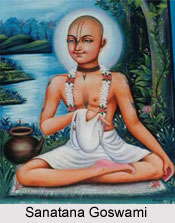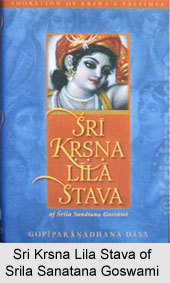 Sanatana Goswami was a principal disciple of Chaitanya Mahaprabhu and thus a prominent figure in Vaishnava Literature. Sanatana had been the author of a number of significant works in the Bhakti tradition of Gaudiya Vaishnavism and was the senior most of the influential Six Goswamis of Vrindavan, and the group even consisted of his brother Rupa Goswami.
Sanatana Goswami was a principal disciple of Chaitanya Mahaprabhu and thus a prominent figure in Vaishnava Literature. Sanatana had been the author of a number of significant works in the Bhakti tradition of Gaudiya Vaishnavism and was the senior most of the influential Six Goswamis of Vrindavan, and the group even consisted of his brother Rupa Goswami.
Early Life of Santana Goswami
Sanatana Goswami or Santosha which was his birth name was born originally in Jessore, currently at Bangladesh, in 1488 as the son of Mukunda, the private secretary of the Sultan of Bengal, Jalaluddin Fateh Shah (ruled 1481-1487 CE). Sanatana was the eldest son of Mukunda, and his younger brothers were Amara (Rupa Goswami) and Srivallabha (Anupama). Sanatana and his brothers studied Nyaya and Vedanta from the famous logician Vasudeva Sarvabhauma Bhattacharya and also studied under Sarvabhauma`s brother, Madhusudana Vidyavacaspati, from whom Sanatana took initiation in his childhood.
After his father demised Sanatana was almost forced to take up the post of Sakara Mallika (treasurer) to the new ruler of Bengal, Alauddin Hussein Shah (ruled 1493-1519 CE), while his brother Rupa was given the post of Dabir-i-khas or the post of private secretary). It was during his youth that Shri Sanatana dreamed of a beautiful brahmana boy who gave him a Shrimad Bhagavatam. Feeling ecstatic at heart he awoke. But seeing neither the boy nor the Bhagavatam he felt sad. When Sanatana began his puja that morning, however, Krishna Himself, disguised as a beautiful brahmana boy, came and said, `Take this Shrimad Bhagavatam from Me, always study it, and you will attain perfection. "
In Krishna-lila-stava, Shri Sanatana Goswami glorifies the Shrimad Bhagavatam: "0 oly Bhagavata, you are my only company, my only friend, and my guru. You are my greatest treasure and my personal saviour. You are the emblem of my highest fortune and the very form of ecstasy. I offer my obeisance unto you."
Hinduism was at stake during that age and forced to submit to the ruling Muslim government, Shri Rupa and Shri Sanatana became ministers and lived at Ramakeli. But their real engagement was teaching shastras which they learned from Vidyavachaspati, brother of Sarvabhauma Bhattacharya. Pandits and brahmanas from all over India came to study under the two brothers. Shri Rupa and Sanatana were acclaimed as the "crest jewels of the Gaudiya Vaishnava scholars." After the Lord visited Ramakeli and freed them, they renounced everything for Lord Gauranga`s service.
Sanatana and Rupa met Chaitanya at Ramakeli in 1510. Thereafter After meeting them, Chaitanya gave them the names Rupa, Sanatana and Anupama. Due to this meeting, the brothers decided to renounce the world and join Chaitanya and his entourage. As Sanatana refused to serve the Nawab any more he was sent to prison. While in prison, he received a letter from his brother Rupa telling him that Chaitanya had left Puri to go to Vrindavan. Sanatana managed to bribe the jailer with money and then crossed the Ganga River and reached Vrindavan.
Thereafter when he came to know that Chaitanya had left Vrindavan, then he went to Benares. There Chaitanya gave him instructions realting to sambandha-jnana. He his teachings to Sanatana by summarizing them: sambandha, abhidheya and prayojana. Later when Sanatana went to Puri he met Chaitanya once again. He was instructed by Chaitanya: to write books teaching Bhakti yoga, to discover the places in Vrindavan where Krishna had his pastimes, to establish service of deity of Lord Krishna in Vrindavan and to compile a book that would explain the proper behaviour for devotees of Krishna in order to create the foundations of a Vaishnava society.
 They travelled extensively through Vraja mandala discovering many lila sthanas of Radha-Madhava. Having no fixed residence, they would catch a few winks of sleep (no more than one and a half hours per day) under a tree or bush. Shri Rupa and Shri Sanatana Goswamis spent all their time writing, discussing Krishna`s pastimes, and chanting Krishna`s Holy Names.
They travelled extensively through Vraja mandala discovering many lila sthanas of Radha-Madhava. Having no fixed residence, they would catch a few winks of sleep (no more than one and a half hours per day) under a tree or bush. Shri Rupa and Shri Sanatana Goswamis spent all their time writing, discussing Krishna`s pastimes, and chanting Krishna`s Holy Names.
Sanatana Goswami located various lost holy places. He established the worship of the deity of Madana-mohana. Thereafter a rich officer in the Mughal army named Krishna Dasa Kapura built a temple for Madana-mohan that later became one of the seven principal temples of Vrindavan. He died in the year 1558 CE and his tomb is located next to the Madana-mohana temple.
To maintain himself Sanatana would beg some wheat flour, roll it into a ball by adding a touch of Yamuna water, and drop it in smouldering coals to cook.
He would offer this bati (salt-free, baked bread ball) to his Deity of Madana Mohana. Giving up all kinds of material enjoyment, the Goswamis accepted the poorest way of life as mendicants. They ate just enough to maintain their bodies. The Radha-Madana Mohana mandir established by Sanatana Goswami was the first one opened in Vrindavana by the six Goswamis. Described as "the personal extension of the body of Shri Chaitanya Mahaprabhu," Shri Sanatana is the ideal spiritual master because he gives one shelter at the lotus feet of Madana Mohana. The three Vrindavana Deities (Madana Mohana, Govindaji and Gopinatha) are the life and soul of the Gaudiya Vaishnavas. The Deity of Madana Mohana has the specific quality of helping the neophyte Devotees understand their eternal relationship with the Supreme Personality of Godhead, Lord Shri Krishna.
Contribution of Santana Goswami
Sanatana Goswami wrote four important books in Sanskrit on Gaudiya Vaishnava philosophy:
Brihat-bhagavtamrita ("The Great Nectar of the Lord`s Devotees")
This work of 2,500 verses is divided into two parts. The first section explains the ontological hierarchy of the devotees of Krishna. The second section deals with the soul`s journey to the eternal realm of Krishna. Narrated as stories, both sections explain many aspects of Gaudiya Vaishnava philosophy. Sanatana also wrote for this book his own commentary, called the Dig-darshini.
Hari-bhakti-vilasa ("Performance of Devotion to Hari") a book that was a joint work between Sanatana Goswami and Gopala Bhatta Goswami. Compiled on the order of Chaitanya Mahaprabhu; this literary piece deals with the rituals and conduct of Gaudiya Vaisnavas. Sanatana also wrote an auto-commentary on Hari-bhakti Vilasa.
Another literary work had been Krishna-lila-stava ("Glorification of the Pastimes of Krishna")Krishna-lila-stava consists of 432 verses tracing Krishna`s pastimes as told in the Bhagavata Purana, from the beginning of the 10th Canto up through the vanquishing of Kamsa. Krishna-lila-stava is also sometimes referred to as the Dasama-charita.
Brihad Vaishnava Toshani ("That which brings Great Joy to the Devotees of Krishna")
The Brihad Vaishnava Toshani is Sanatana`s extensive commentary on the Tenth Canto of the Bhagavata Purana. This commentary is also known as the Dasama-tipanni. Contribution of Sanatana goswami even includes the worship of the Madana Mohana deity. With the help of a wealthy merchant Krishna Dasa Kapoor, an elaborate and lavish temple was built for Sri Madana Mohana. This temple is an important place of pilgrimage for all Gaudiya Vaishnavas even to this day. Sanatana Goswami breathed his last at the age of 70 in 1558.



















